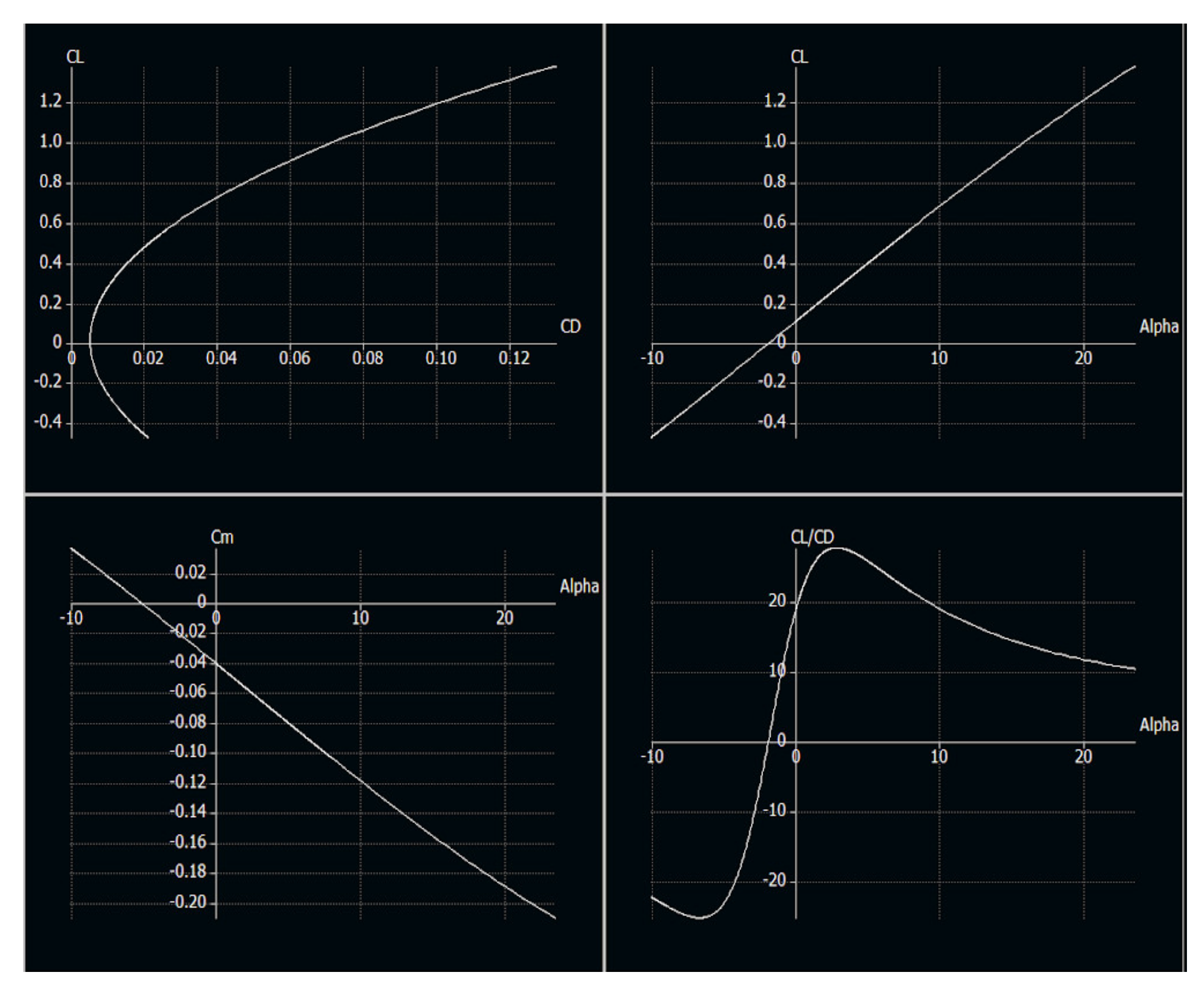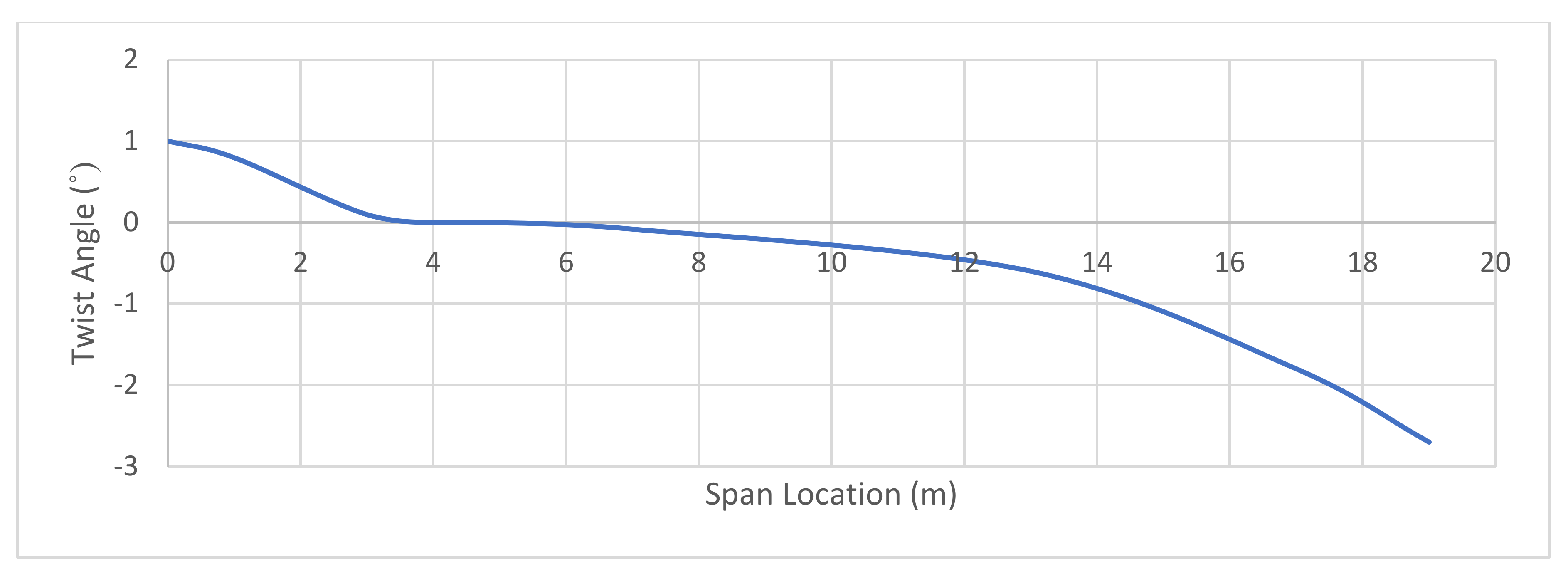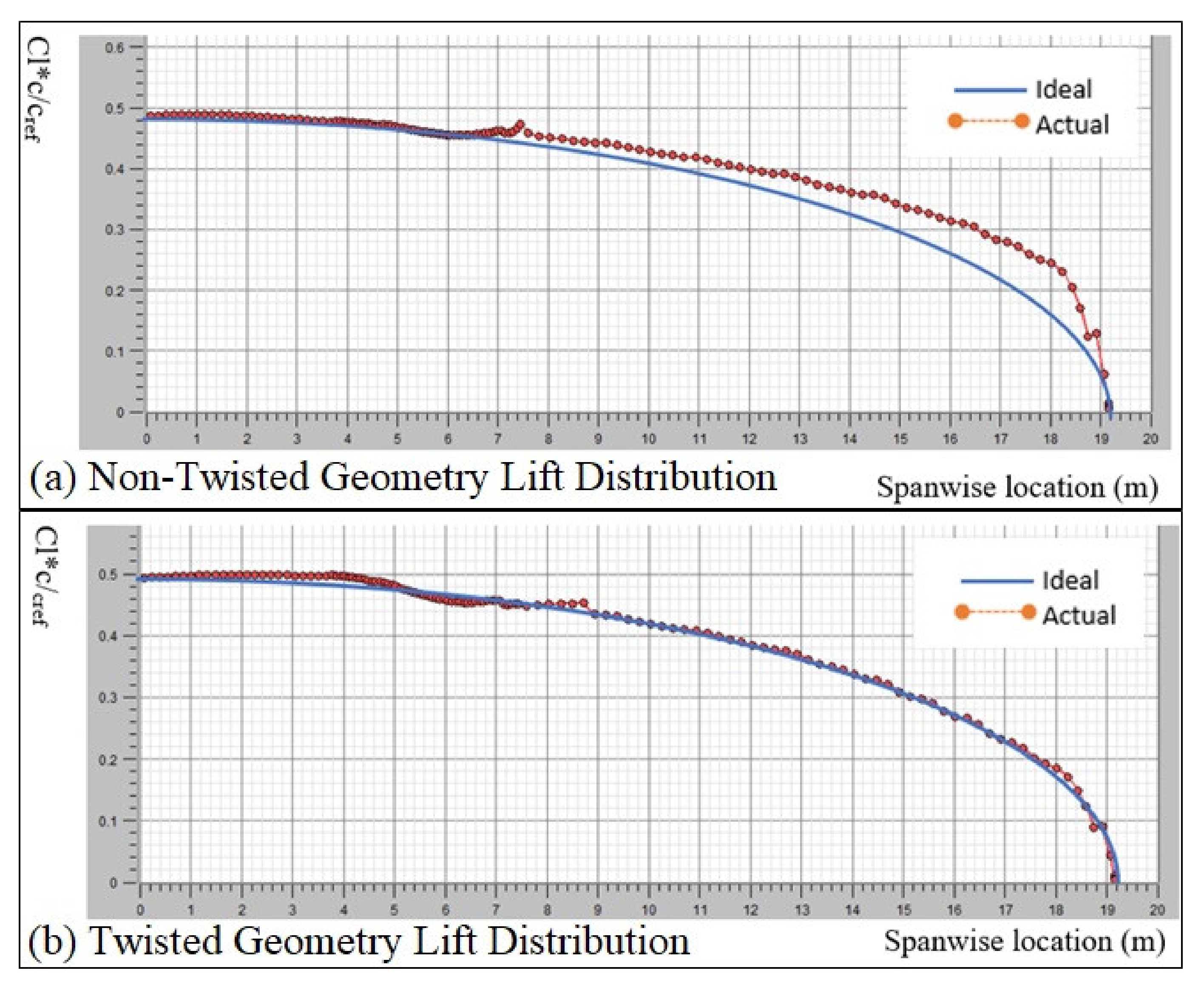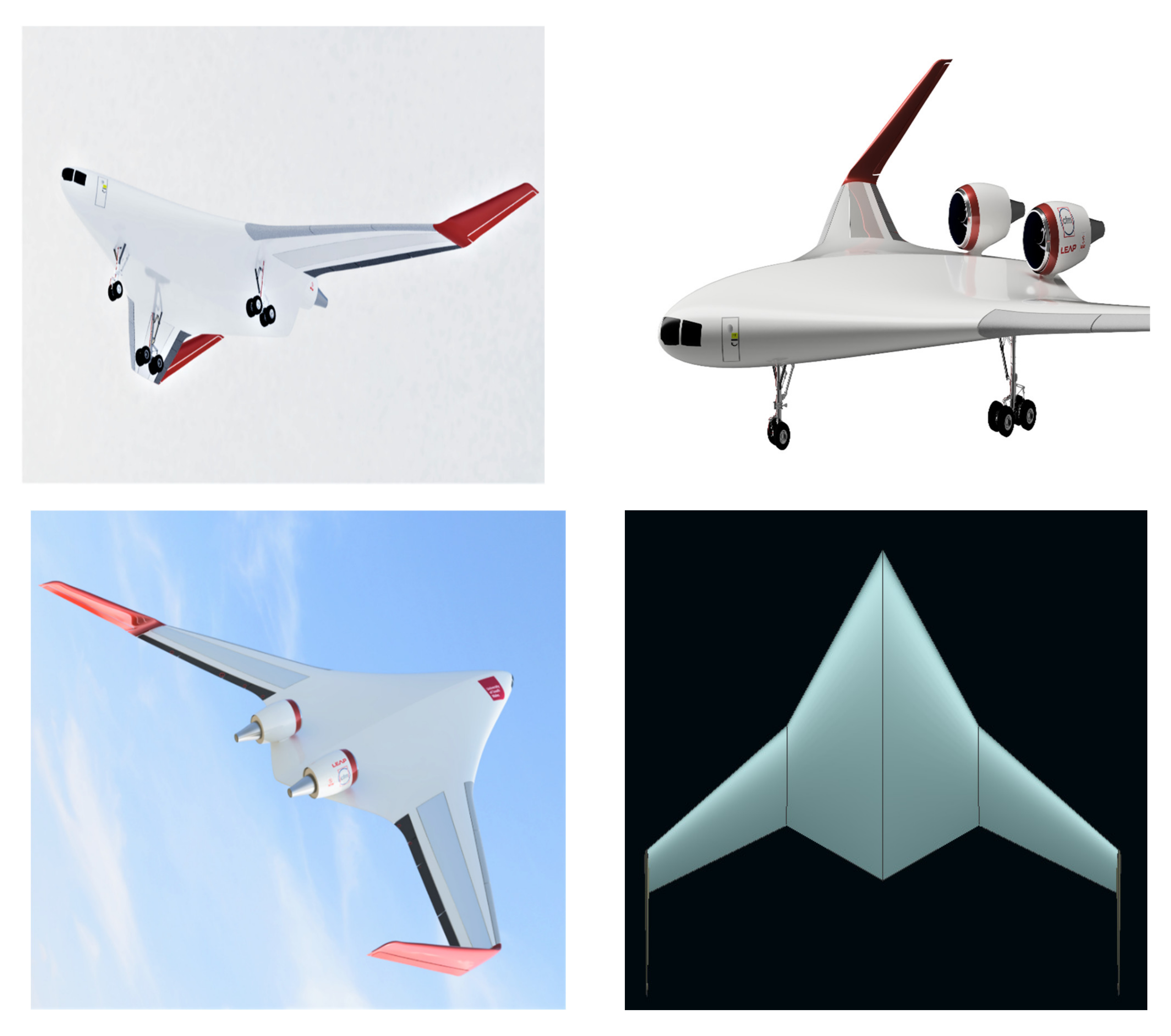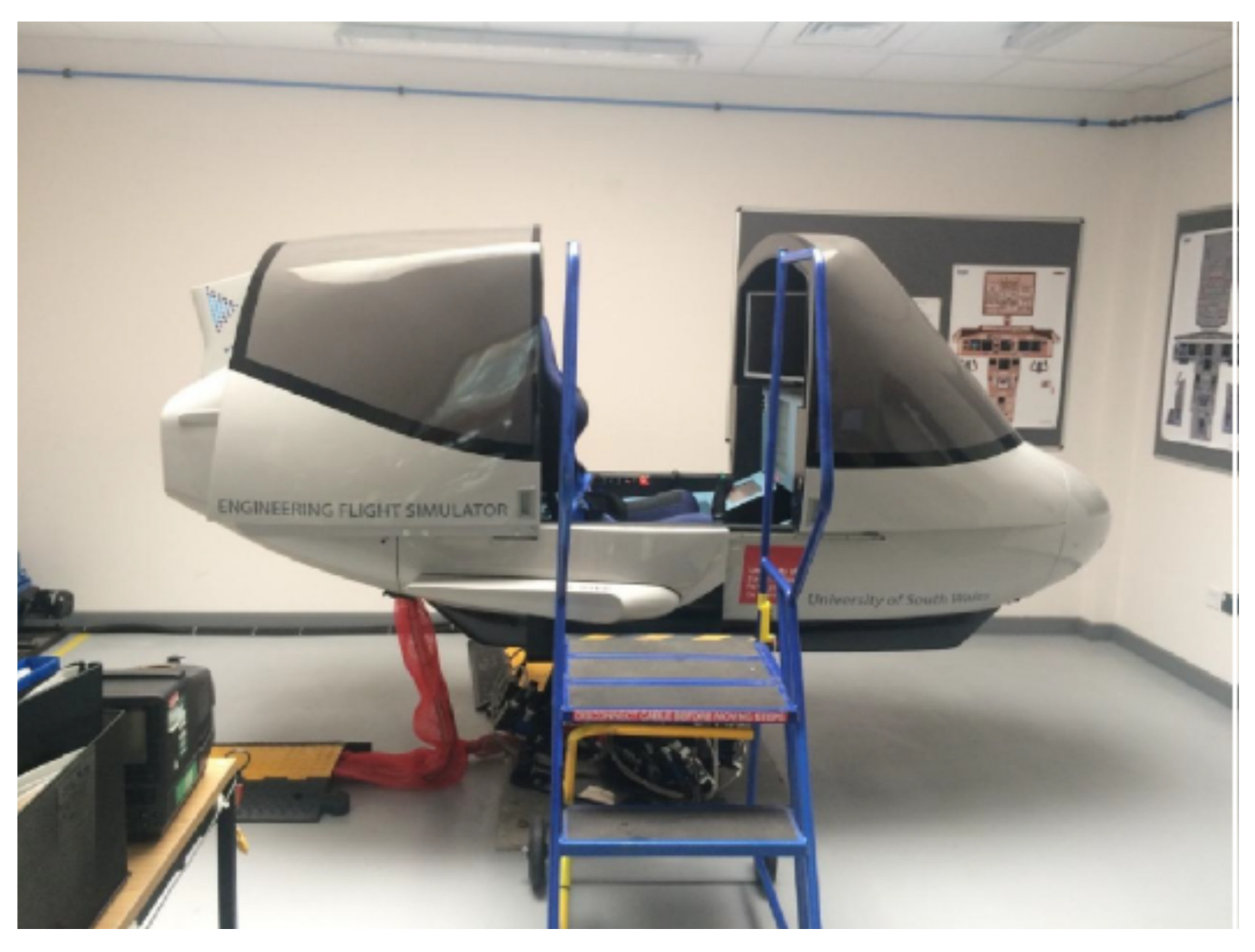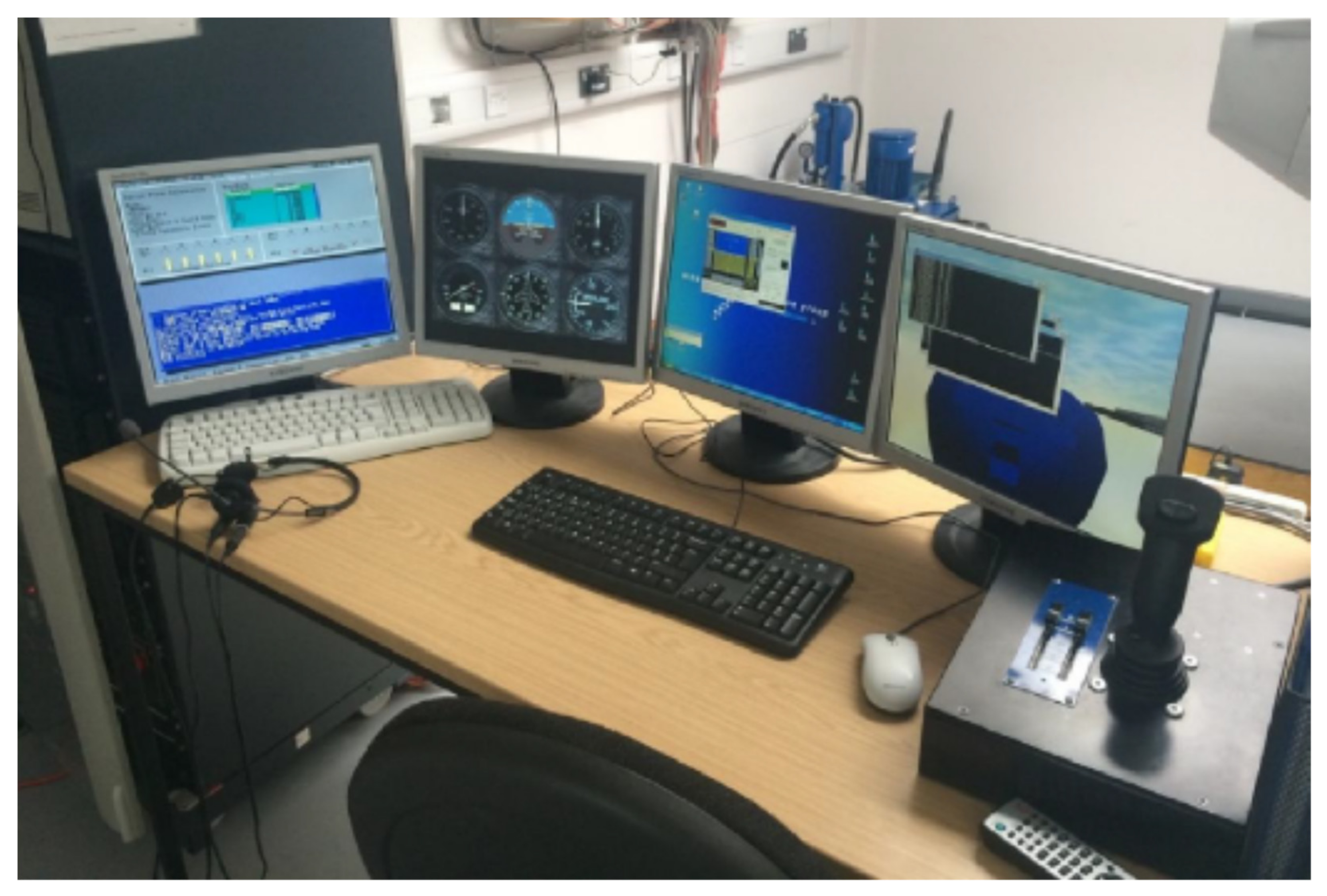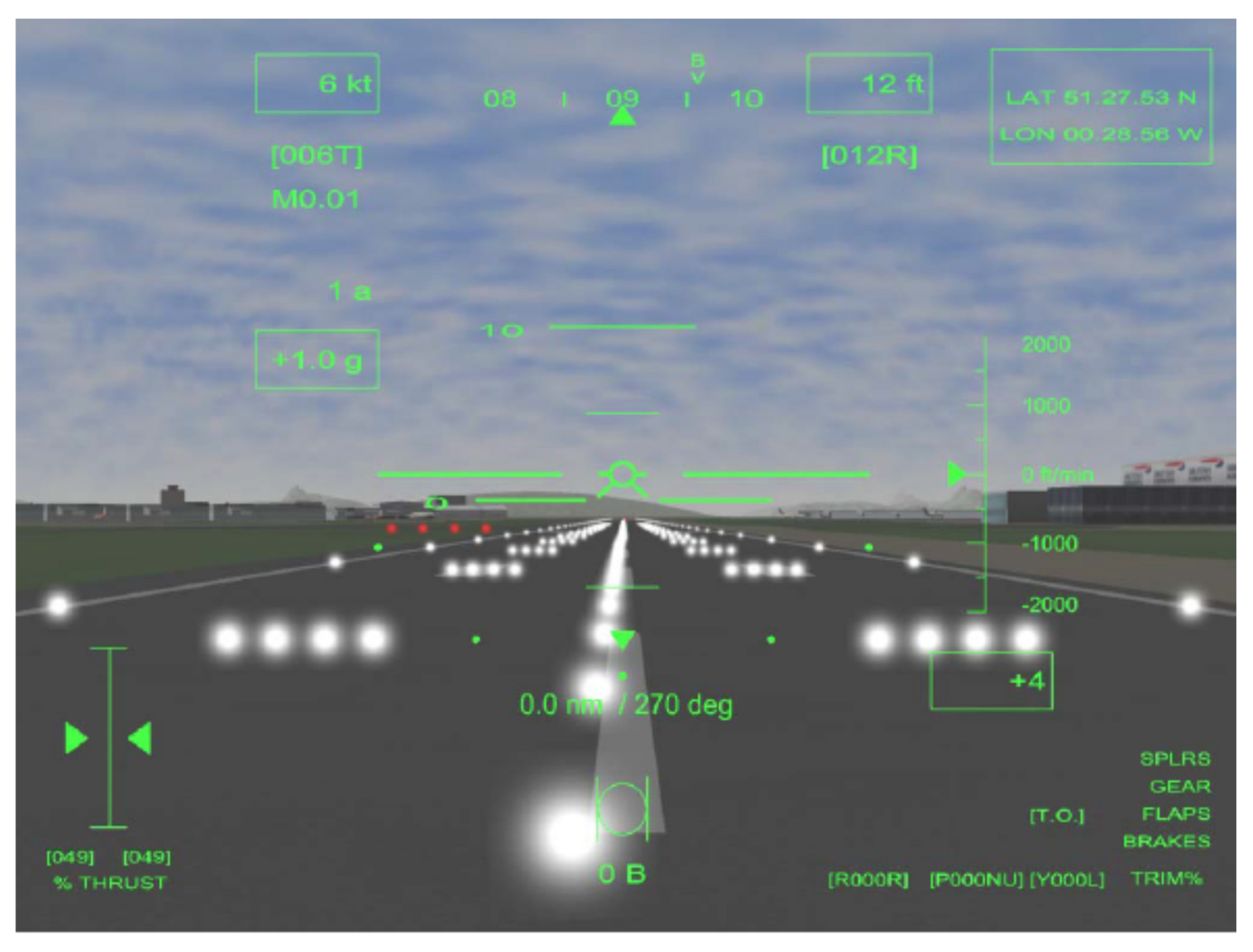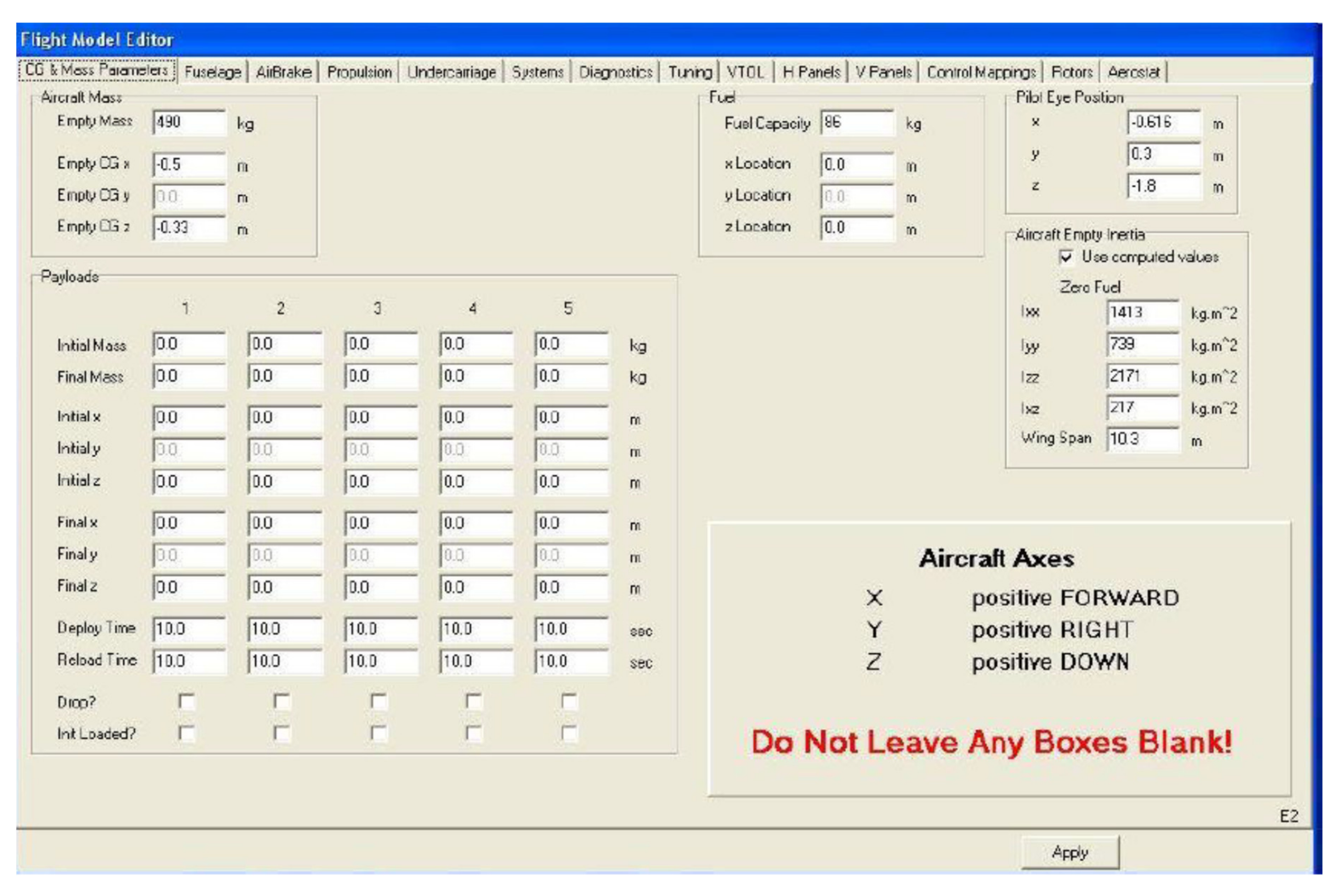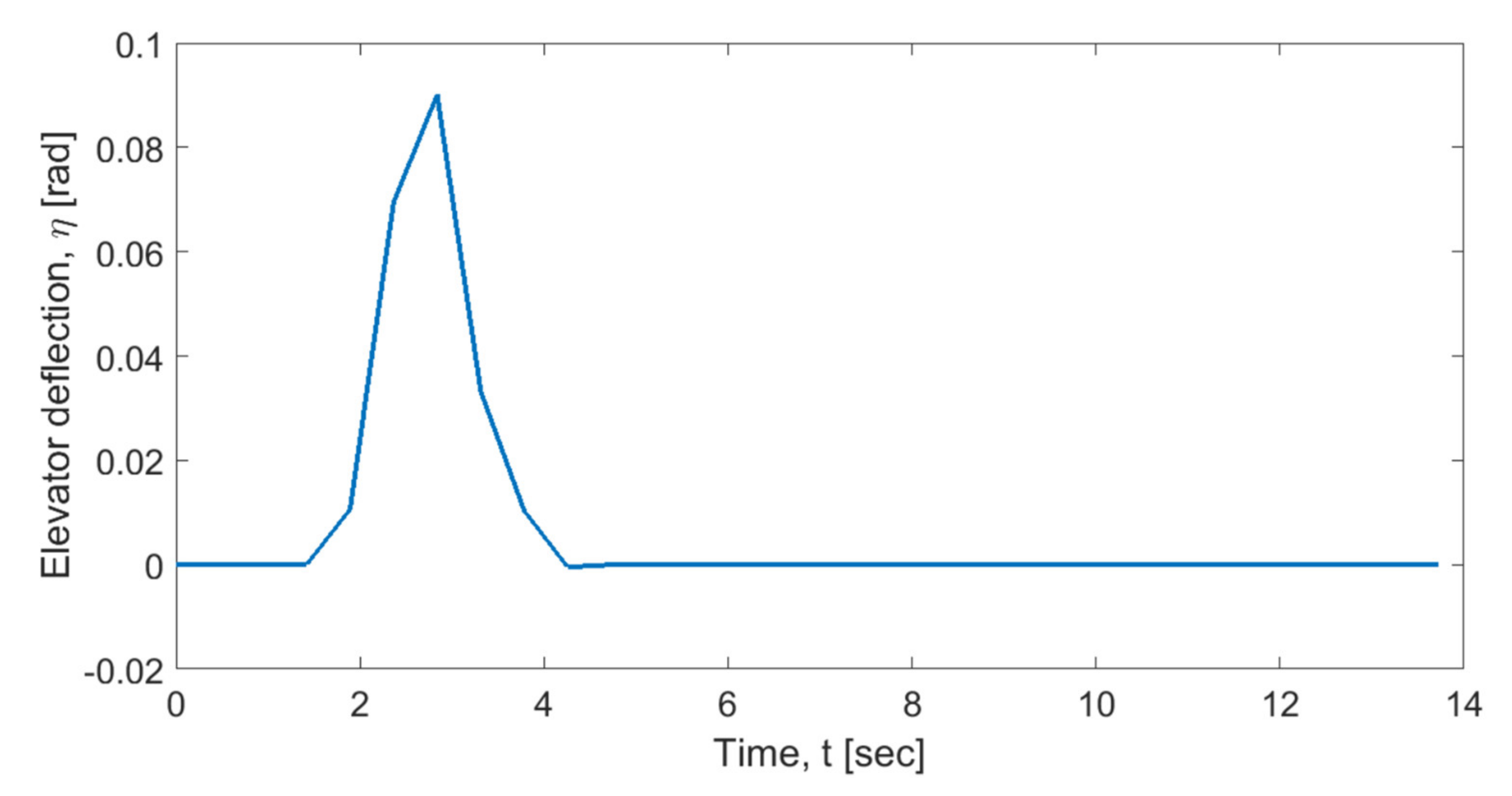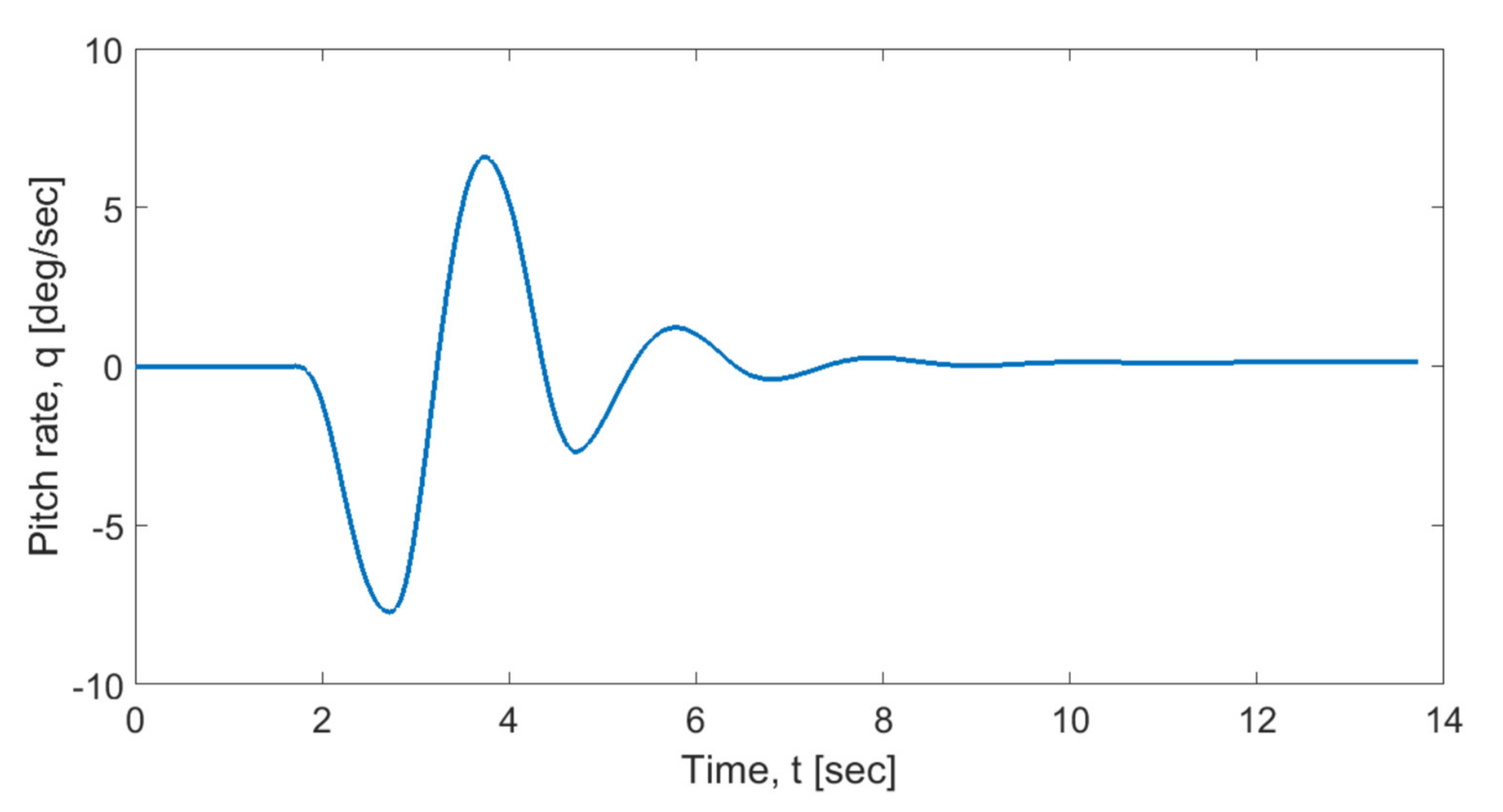2.1.1. Weights
Several studies have addressed the topic of developing a high capacity BWB design [
1,
2,
13]. However, following relevant market research [
14,
15], it has been determined that the present study will attempt to provide a solution to the increasing future demand for a single aisle passenger aircraft. A BWB design of similar passenger capacity has been developed to compare its performance against an equivalent conventional Airbus A320 aircraft [
16]. The design of the present study is set to achieve a range of 3000 nautical miles and to carry a payload weight of 20,000 Kg or 200 people plus baggage. A typical mission profile for a passenger aircraft has been assumed (Taxi, Warm Up → Take off → Climb → Cruise → Loiter → Descend → Landing and Taxi) and the weights have been calculated using a combination of methods. Mariens [
17] and Roskam [
18] methodologies have been used for the estimation of the fuel required for the baseline mission profile. Those methodologies use the Breguet performance theory together with statistical factors which estimate the fuel weight of each segment of the mission.
Table 1 shows the values of the fuel fractions for each segment of a typical mission.
The fuel weight fraction
Mffi is defined as the ratio of the total aircraft weight at the end of the flight segment to the total weight of the aircraft when the segment has begun. Thus, the total fuel weight fraction defines the burned fuel as a ratio of the total aircraft weight at the end of the mission to the total aircraft weight at the beginning of the mission. As such, the total fuel weight fraction can also be expressed analytically as the product of all the fuel weight fractions, as per Equation (1)
Initial weight approximations have been calculated using empirical relations from Raymer [
19]. The approximations were then refined once again after the basic geometry was established and then iterated to converge. By estimating the maximum take off weight (MTOW) and the maximum zero fuel weight (MZFW), the weight of the aircraft at cruise
Wcruise, was estimated by Equation (2) [
20]
The final weight estimates are defined in
Table 2, which also compares the weight estimates of the model with the weight data of the baseline version of the Boeing 737-800 aircraft [
21].
A sizing methodology for the conceptual design of BWB transports has been suggested by Bradley [
22]. His study compares, among others, weight estimates of BWB designs having 250 to 450 passengers with weights of similarly sized conventional passenger aircraft. It has been observed that the weight trends among the BWB configurations show a similar pattern to the conventional transports. The BWB of the present study offers an enhanced payload capacity when compared to the similarly sized (similar MTOW) Boeing 737-800.
2.1.2. Wings
Once the weights were determined, the wing geometry was able to be defined; this was calculated for the main wing section using the Boeing 787-800’s Aspect Ratio (AR) of 9.44 [
23] as an initial reference value. In addition, the sweep of the outboard wing was determined to be 40 degrees, while the sweep of the inboard wing as 58 degrees. This was chosen since it provides the highest lift-to-drag ratio for a slight negative moment generated at the wings [
24,
25]. The design of the wings has adopted best practices of previously published BWB studies [
1,
9,
10,
16,
22] with values for certain wing design parameters (taper ratio for example) that have been based on their potential for achieving a wing that is as efficient as is practicable. The best practices show that the wing area of a BWB should normally be a multiple of the wing area of a conventional passenger aircraft having a similar MTOW. This leads to lower wing loading (W/S) values for the BWB designs and as such, from a performance point of view, the potential of the BWBs to achieve high values of maximum speed is limited. Instead, it offers flexibility in terms of sizing the flaps of the wing, as the lower W/S values incur lower stall speeds than the conventional configurations. This has been evident for the BWB design at the performed flight test. With regards to the AR value, various ideas and approaches have been explored and tested in conjunction with the decision for the most suitable sweep angles. The benefit of using the engineering flight simulator has enabled the testing of various embryonic wing shapes with different parameters at the early stages of the development. Thus, the wing configuration has been finalized by using performance, handling and stability criteria, in line with the objectives of the study. The benefits of the sweep angle to both the directional and lateral stability of the platform, as well as to the relative position of the aerodynamic center with respect to the center of gravity (CG) and to delaying the transition to transonic speeds have been prioritized, resulting in an AR value of 4.25, while the wingspan was kept close to the value of the Boeing 737-800.
The tendency of the BWB aircraft is to pitch up due to the position of the aerodynamic center typically being in front of the CG, and no horizontal stabilizer or tail to counteract it [
26]. This can be counteracted using mass positioning but also negative moments. Having taken into account all those considerations,
Table 3 outlines the results for the wing geometry.
Rudder winglets have been used for adequate yaw control as a design feature which has been tested at previous BWB passenger aircraft studies [
1,
10]. Post flight test simulation analysis has resulted in changing the geometry of the rudder winglets initially used to aid in directional control. An initial reference value of 20% of the semispan [
27] of the wing of the BWB had been taken at the early development stage for the span of the winglet rudder. This was a value of 3.68 m which had to be increased, due to not being adequately reactive with pilot input. Following the feedback received by the test pilot during the execution of the dynamic stability modes, the span has been finalized to 4.5 m, with a chord length of 0.45 m. The literature shows that rudder winglets have been also used at smaller sized platforms, providing not only yaw but pitch control as well [
28].
The chosen aerofoil for the inner wing and fin was the supercritical NACA sc0012 as this has been proved to be the most appropriate for the flying and handling qualities for the BWB design during the flight test simulations. Non-symmetric aerofoils like the supercritical NACA sc2412 have been tested as well. However, that aerofoil was used for the outer wing based on its efficiency and on the fact that it has the same thickness-to-chord ratio as the one used for the inner wing. From the data created by XFLR5 (v6.47), shown in
Figure 1, it is observed that the aircraft is stable straight off with a negative gradient for the moment coefficient c
m. The neutral point was determined to be at 13.41 m from the nose, and the CG at 12.34 m. This meant a static margin of 8.65% of the MAC, meaning that it is stable, and above the recommended 5% static margin.
Further development of the wing has been undertaken to enable a more efficient design and the effort has yielded positive outcomes with regards to the flying and handling characteristics of the BWB design. As a first step in reshaping the wing geometry, the main approach that has been considered was imprinting the elliptical lift distribution, which results in the lowest induced drag for a given span [
29]. To achieve the specified distribution, the overall geometry of the BWB design has been incorporated to the OpenVSP (v3.17.0), which employs the vortex lattice method (VLM). The methodology implies the variance of four different twist values at different spanwise positions.
Figure 2 shows the twist values along the wing. Comparatively, Qin et al. [
30], have determined using a low fidelity panel method combined with high fidelity RANS approach that, among other findings, a twisted wing with a mix of triangular and elliptical distribution is best as a compromise between least wave drag for the triangular and the lowest induced drag for the elliptical distribution.
The resulting drag coefficient reduction is presented at the
Table 4.
The sectional lift coefficient required for the elliptical lift distribution follows a steadily increasing trend from the centerline section plane of the BWB design until the beginning of the wing, as shown in
Figure 3. A more visible increment is noticed from the beginning of the wing until a maximum is reached at approximately its middle section. Then, a steep decrease is noticed until the beginning of the winglets.
Kumar and Khalid [
31] have used the same trend of the sectional lift coefficient for a similar BWB concept. However, the method used in the present study for obtaining the twist angles is based on the lift curves. Using a low fidelity panel method, Qin et al. [
10,
30,
32] have managed to achieve an elliptical lift distribution and the present study has benefited from their method to achieve a similar distribution following the re-shaping of the BWB wing, as shown at
Figure 4.
As a further step when exploring a more robust optimization method of their designs, they have employed a high-fidelity RANS approach and this is also recommended by related studies of Panagiotou et al. [
28] and Da Ronch et al. [
33]. Various views of the re-shaped configuration are shown at
Figure 5.
